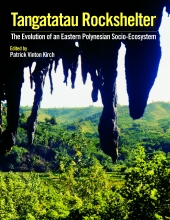Tangatatau Rockshelter: The Evolution of an Eastern Polynesian Socio-Ecosystem

Backlist
Series: Monumenta Archaeologica 40ISBN: 978-1-938770-10-4
Publication Date: Mar 2017
Price: Hb $98, eBook $45
Order this book here!
- Print: Order from our distributor
- Electronic: Kindle eBook
- Open Access: PDF
Return to catalog
Patrick Vinton Kirch
“Archaeologist Patrick Kirch here cuts through an archaeological situation of uncertainty to find a mother-lode – a site that immediately throws an immense amount of light on a prehistoric situation that was hitherto obscure.”
— Peter Bellwood, The Journal of Island and Coastal Archaeology, 2017
“The monograph is exemplary as both a final archaeological site report from Polynesia and a multi-faceted contribution to Polynesian island settlement studies. On both counts, it should serve as a high benchmark for others to follow.”
— Ian Barber, Archaeology in Oceania, 2018
Tangatatau Rockshelter on Mangaia Island (Southern Cook Islands), excavated by a multi-disciplinary team in 1989-1991, produced one of the richest stratigraphic sequences of artifacts, faunal assemblages, and archaeobotanical materials in Eastern Polynesia. More than 70 radiocarbon dates provide a tight chronology from AD 1000 to European contact (ca. 1800). The faunal assemblage provides compelling evidence for dramatic reductions in indigenous bird life following Polynesian colonization, one of the best documented cases for human-induced impacts on island biota. 
Tangatatau is unique among Polynesian archaeological sites in the extent to which fishing was dominated by freshwater fishes and eels. The site also yielded an extensive suite of carbonized plant materials, including sweet potato tubers, demonstrating that this South American domesticate had reached Eastern Polynesia by AD 1400. Mangaia illustrates the often far-reaching consequences of human land use and resource exploitation on small and vulnerable islands.



